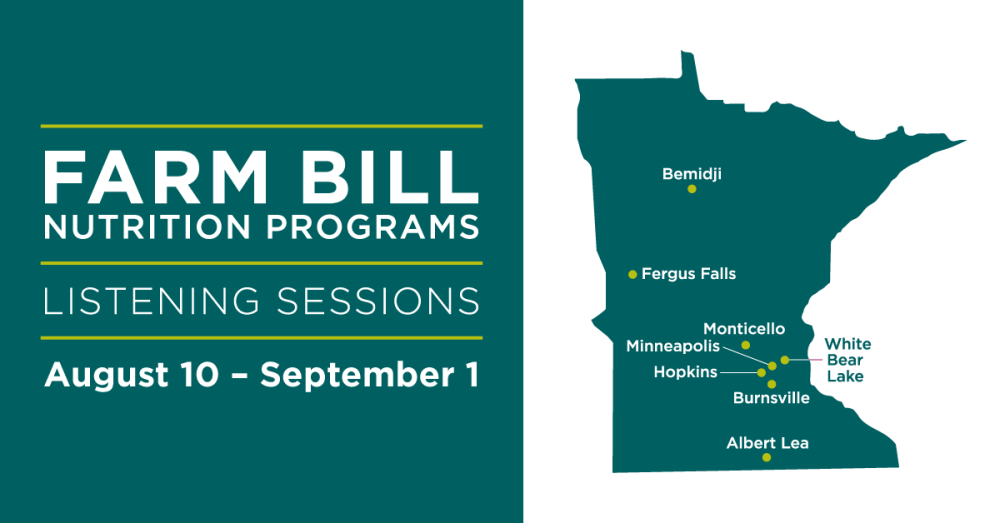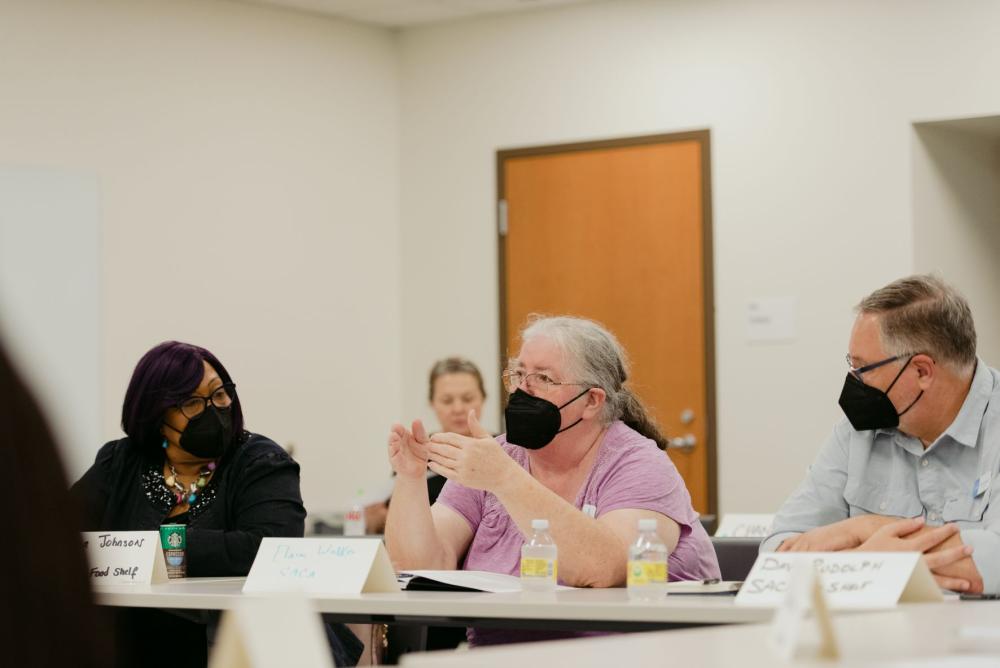
Farm Bill Listening Sessions
This summer, Second Harvest Heartland hosted eight Farm Bill listening sessions in partnership with Minnesota’s other Feeding America food banks. These statewide events brought together food shelf staff, pantry clients and SNAP participants to discuss how Farm Bill nutrition programs can be strengthened and improved, in part to help address challenges coming out of the COVID-19 pandemic.

COVID-era challenges and innovation
While the pandemic undoubtedly brought additional challenges and hardship to all of us, many participants recalled some silver linings. Most hunger-relief organizations reported that at the beginning of the pandemic, their food shelves were well-resourced through increased community and government support. COVID-era safety protocols also spurred innovative ways of distributing food to their communities. Many organizations were able to begin mobile distributions, host pop-up sites and even build new infrastructure (like additional cold storage space or online ordering platforms) to meet growing demands.
Event participants also reported that during parts of 2020 and 2021, the number of visitors actually decreased because clients were receiving additional financial support through stimulus checks, enhanced unemployment benefits, expanded Supplemental Nutrition Assistance Program (SNAP) benefits, or advanced Child Tax Credit payments.
Now, however, most of these expanded programs have lapsed, and the demand for food assistance has greatly increased across the state as grocery, rent and gas prices increased starting in 2022. All these pressures have greatly strained family grocery budgets, and food shelves are busier than ever.
At the same time, the same supply chain challenges affecting retailers are also hitting the emergency food system, while government support for sourcing food through programs like The Emergency Food Assistance Program (TEFAP) are down about 50% compared to 2021.

Caption: Stephanie Lehman, executive director at Anoka County Brotherhood Council (ACBC), discusses Farm Bill priorities at the session in Monticello.
Stephane Lehman, Executive Director at Anoka County Brotherhood Council (ACBC), illustrated the challenges her organization is facing during a listening session in early August. “In July, we served 4,500 people out of our food shelf. But donations are down for rescues, food availability is down… we are like hitting reset at the food bank, ordering, trying to pick up whatever food we can get.” Their food shelf, located near Anoka, MN, served 40% more families in 2022 compared to 2021.

Caption: Elaine Walker, representative from SACA Food Shelf, discusses the importance of delivery programs with her colleague Dave Rudolph and Theresa Johnson from Shiloh Cares Food Shelf at the listening session in Minneapolis.
Elaine Walker, co-director of the South Anoka Community Assistance (SACA) Food Shelf, discussed challenges with maintaining COVID-era innovations, like home-delivery for seniors, now that government funding had ended. “For the senior delivery program, we can’t take anymore. We’re bursting at the seams. How do we help these people? We were able to help them for almost two years, and then they just got cut off.” The need for resources to support transportation was expressed at sessions across the state, from the Twin Cities metro area to Bemidji and Fergus Falls.
Policy Priorities for the 2023 Farm Bill
Luckily, the Farm Bill is our next best chance to pass policy that can help address the needs expressed by listening session attendees, and to change programs so that they’re better able to respond to crises like COVID-19 to prevent these situations in the future.
Here are some of the policy priorities we heard across the state:
Increase the minimum benefit amount for SNAP/EBT up from $16 for the highest income participants, and make overall benefits more adequate to cover the cost of a nutritious diet.
“SNAP benefits are really the way people can go out and buy the food that they really want. It's not beholden on us having [those foods] at the food shelf or for delivering into their house."
- Jen Winterfeldt, Director of Development and Community Engagement at Keystone Community Services
“For every meal we provide, SNAP provides nine more. So that’s where it would really make a difference and then it goes right to the stores, and people get to choose exactly what they want.”
- Susie Boelter, Executive Director of North Country Food Bank
Increase eligibility for federal nutrition programs so that all people experiencing food insecurity can access them.
“A family of four living on $40,000 per year is not going to happen in today’s market and economy. With housing, transportation and all the other things that go into life—the basic necessities and cost of inflation, that just makes it so challenging to get those basic needs met.”
- Kasey Meyer, social worker at Dakota County Technical College
“The face of the shoppers is changing. The demographic—what a food shelf visitor may represent – is changing and expanding and it is going into two working parents in the home. It’s changing and we need to adapt to that.”
- Heidi Skinner, United Way of Freeborn County’s Welcome Pantry food shelf
“It’s hard for college students to access [SNAP]. Now, they have some exemptions and temporarily, in the pandemic, they added exemptions where students have a 0% expected family income from their financial aid or if they qualify for work/study, which basically means that they have some significant level of financial need and they… they still have to meet income restrictions, but those are temporary and those are set to sunset unless something changes in the Farm Bill.”
- Paige Wheeler, Normandale Community College

Caption: Some of the listening session participants in Bemidji. From left to right: Laurie Buehler, Bemidji Community Table; Vicky Menendez, Polk County Social Services, and Deanna Hron, Deer River Schools.
Streamline the eligibility and enrollment process for SNAP participants, making it easier to get, keep, and use EBT cards.
“Anything the Farm Bill can do to broaden participation in SNAP, make sure that it’s actually beneficial to take the time and effort to participate, that’s going to ease the burden on all of us.”
- Jason Viana, Executive Director of The Open Door Pantry
“[I chose] everything related to making SNAP easier and less restrictions on what people can get. I mean, not allowing people to get hot meals on SNAP, it doesn't make sense if they're homeless, you know? They need that food. So I think raising the benefits, making it easier and reducing the barriers on what people can get. Don't decide for folks.”
- Deanna Hron, Full Service Community School Coordinator for Deer River Schools
“The online SNAP application has really helped. When people see a lot of papers, there’s a language barrier. They get the whole application in the mail and it’s 23 pages, and they get scared, and then they don’t apply. Or they say, ‘I didn’t understand. I didn’t get the Spanish copy.’ I really love the online application because it’s easier, it’s faster, and it’s in Spanish as well.”
- Martha Gonzalez, CLUES Austin
Increase federal government spending on food distributed through food banks and other hunger-relief organizations, provide greater compensation for storage and distribution costs to deliver that food.
“I feel very lucky because [Keystone and Second Harvest Heartland] both delivered groceries directly to my senior building in St. Paul. I have experienced food insecurity in my life and when I retired and couldn't work anymore, I didn't know how I was going to be able to afford food.”
- Jean James, Keystone Community Services client
“We also do a ton of deliveries. We've increased by more than eleven times what we did before. So what we did in a year before, we do in a month now. So that's been a big difference for us. So we're investing some energy and how to be more efficient with that.”
- Paul Jacobson, Basic Needs Director at VEAP
“So from May 2021-May 2022, our food shelves have seen anywhere from a 60%-130% increase in that year. And so we are now scrambling, trying to figure out where we’re going to get this food from, how we’re going to pay for this food, and how we’re going to meet this food demand that we aren’t used to seeing, as well as training those new staff that don’t know what a food shelf was like pre-pandemic.”
- Elizabeth Koehl, Prairie Five Community Action
Increase income eligibility for participation in the Commodity Supplemental Food Program (CSFP) and provide greater choice in the quantity and variety of foods to meet participants’ nutritional needs and preferences.
“Just two weeks ago, I had a senior lady who said to me, ‘If I had a few extra bucks, I could go buy flour and butter so that I could make the cookies that I would otherwise have to go to the grocery story and pay three times the amount for.’ But those kinds of basic supplies aren’t coming in the NAPS boxes… Self-selection for the seniors, at least up in our area, seems to be a really top priority.”
- Ruth Sherman, Community Resource Connections – United Way of Bemidji Area

Caption: Andie Kukacka, St. Peter Food Shelf manager, discusses Farm Bill priorities with food shelf partners in Albert Lea. Representatives from UW Freeborn County, Channel One Food Bank, Community Pathways of Steele County, and CLUES attended.
Increase the share of federal government commodities spending that goes to buying food from small, emerging farmers and farmers of color.
"The number of people who are willing to bring fresh produce to our facility has increased significantly... It cuts pressure down on the overall industrial food system. We don’t need to ship fresh produce to Minneapolis that comes from rural Wisconsin if you have people who are willing to hand off their extras to their local food shelf.”
- Andie Kukacka, Director of St. Peter Area Food Shelf
“I think at its heart, the Farm Bill is not only a way that we can really create food access in our communities, but it’s also an agricultural development bill. There’s so much potential where programs like SNAP can not only boost food access in our community, but also invest in growers and in agriculture that is the backbone in Minnesota as an agricultural state.”
- Theresa McCormick, Executive Director of The Good Acre
So, what’s next?
Second Harvest Heartland will continue to engage with our community partners and those affected by changes to programs like SNAP, TEFAP, and CSFP. These efforts will inform our advocacy work and the feedback we provide to our federal legislators who will create, vote on and ultimately pass the 2023 Farm Bill.
Want to get involved? Here’s what you can do to support those facing hunger:
Advocate for the policies and programs that will bring meaningful solutions. Join our advocacy list for regular updates and calls to action and follow us on Twitter for the latest information on what’s happening with hunger-fighting programs and policies.
